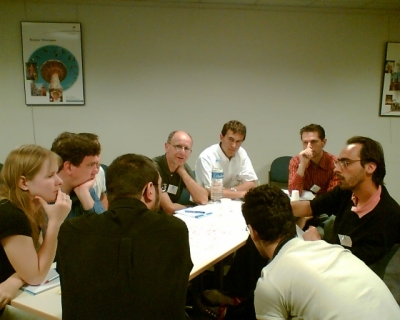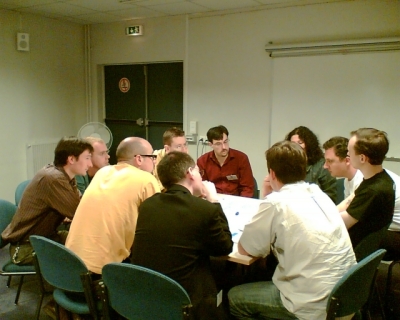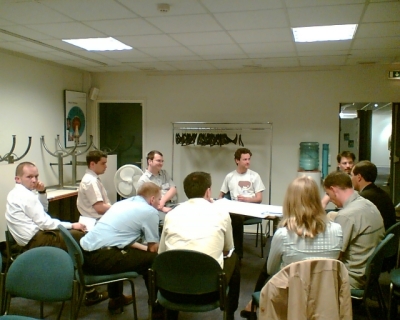Bottle necks in the morning
I arrived the evening before the conference, to be sure that I was in time for my session, which was scheduled as the first session of the morning. I did the “I’m not a bottleneck! I’m a free man!” for the first time in French. We first played a game to learn how to find the “goulots d’étranglement” the 5 focusing steps to “exploiter le goulot, subordonner au goulot et elever le goulot”. At the “OOMPs” where all session presenters briefly explain what their session is about, I said that the session would include chocolate. That seemed to do the trick, because the session was packed with people.
The participants enjoyed themselves playing the Theory Of Constraints simulation. The goal of the simulation is to build as many as possible pairs of paper hats and boats (Throughput), with the minimum number of pieces of paper (Investment). Our Operating Expenses were quite low: one chocolate per worker. We did two rounds of the simulation. After the first round, the team produced one pair, using 11 pieces of paper. In the second round, after optimizing, they produced a pair again (actually, one and a half pairs, but nearly done doesn’t count) using only 7 pieces of paper. The team worked a lot slower in the second round, because they concentrated on quality.
In the second part of the session, (only) three brave souls came forward to play “customer”. Each got 7 or 8 newly minted “TOC consultants” to help them optimize their process and organisation. The groups struggled a bit to describe and understand the processes, but nobody asked me any questions or asked for help. I think I should have subdivided the session into smaller steps, to force the participants to focus on a small bit of the theory, and provide more examples and structure. Still, I think most participants ended up with a good understanding of ToC and ideas to apply back at work. Pictures of the participants in a future entry.
Stories in the afternoon
 In the afternoon, I went to two sessions on user stories and customer collaboration. The first session “Dites-moi, Mr le Client…” was about user stories and the “3 Cs” (Card, Conversation and Confirmation) of customer collaboration.
In the afternoon, I went to two sessions on user stories and customer collaboration. The first session “Dites-moi, Mr le Client…” was about user stories and the “3 Cs” (Card, Conversation and Confirmation) of customer collaboration.
While we waited for the beamer to work, Francois Beauregard told us the story of the “Squirrel Burger“. The moral of the story being that burger flippers being paid minimum wage are often more professional in dealing with customers that most of us developers.
I think it has a lot do with PROCESS. I define process as “the way we do things around here when we’re under pressure“.
Francois then proceeded to tell us more about user stories. We ended with a (short) exercise where we wrote some stories for an online job site for agile developers and companies.
The session was a bit short to include an activity, but the exercise made me want to write stories again. During next day’s breakfast I wrote a set of stories for the ‘Hourensou’ application. That’s the application that we use for the administration of XP Days Benelux. You’ll see more about that later, because there were some stories like “As a potential XP Day participant I want to register myself and my colleagues online, so that I’m assured of a place before it sells out again.”
The second session treated the subject “How to collaborate with multiple clients?“. Dominic, Nicolas and Virgile set up a situation where there were 11 people around the table to do a planning game: 8 customers, 2 developers and a coach/facilitator. Their goal was to write the stories for a remote pair programming tool. There were two rounds of 30 minutes each. The participants had a lot of trouble to come to a consensus about how to pairprogram and how this translates to a situation where the pair is separated.
Remote pair programming interests me too. I’d like to try it a bit more on a few “after hours projects”. The team that developed the “Sun spots” used remote pair programming (almost) exclusively. Maybe Duncan Pierce can tell more about his experiences? Prod, prod… Wouldn’t that make an interesting XP Day session? Hint, hint…
And relax…
After the sessions we emerged back in the light of a beautiful summer spring day. The sessions rooms were underground, so no natural light during the sessions. To make up for it, we spent enough time outside in the garden/terrace. Conversations and discussions continued over beer, aperitif and dinner, while the presidential debate (“Sarko vs Sego”) raged. I met (again) lots of passionate agilists from France, Luxemburg, Switzerland, Canada and Belgium (!).
Bottles in the night
We ended up in a (typical ?) French bar: the waiter couldn’t remember our order (tip: paper and pencil), he dropped a bottle of water on the table when serving us (it could have been worse: he didn’t drop the beer) and the television alternated between clips from the presidential debate and 80’s MTV videos.
All in all, an interesting and exhausting day. And there was more to come the next day…




